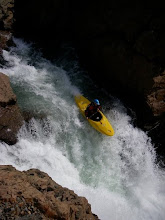
The Boof is one of the most important things to have in your bag of tricks as a kayaker. It can be used in almost any situation, but in general is a maneuver used when going off a drop or through a rapid, if you want to keep your bow up to go over something your bow would typically go under.
There are three main things to consider when boofing: Approach, Stroke and Body Position, and the Landing.
The Approach:
Just like any other stroke in kayaking, you want to plan where you want to go. At the top of a rapid or drop, when planning your boof, think about where you want to finish your boof and in what direction you want to be moving. Typically, if you are wanting to finish the boof right its beneficial to start the boof on the left, so you have some left to right momentum, and vice-versa.
A lot of people tend to struggle with finding the right balance in approach speed. Typically, speed is your friend and will allow you to clear larger holes, or ride up higher on obstacles, however it makes timing more difficult. Some paddlers choose to have only the momentum they need and no more, so as to ensure perfect timing and placement of the boof stroke. For some waterfalls, people choose to move faster than the water, however most choose to move at the speed of the water or slower to ensure control. Once you start boofing things, you'll develop and idea of how much speed and approach angle you need.
During the approach: 1) Have an idea of where you want to be at the end of the stroke, and plan your attack from above 2) Set your speed according to what you're boofing.
Stroke and Body Position:
Timing of the boof stroke can be somewhat difficult, but a good rule of thumb is to never boof before you can see the bottom of whatever it is you are wanting to boof. If you boof before then, chances are you will boof too early and plug the drop. As you're approaching the drop, you want to take that last stroke just as you see the bottom: Reach as far forward as you can with a nice vertical stroke, shoot your hips forward, and before the end of the stroke, sit aggressively forward, (imagine crunching your knees to your chest) in order to raise your bow. This last part is crucial! If you don't sit aggressively forward and bring you knees up, all you did was go over the edge faster.
The Landing:

Jesse Becker leaning forward about to land off Sunset Falls, Wa
Depending on the height of the drop, the aeration in the pool below, and the strength of your boof stroke, flat landings can be very hard on both your back and your face. In general, you want to be careful boofing anything over 20 feet to avoid compression of your spine. After you've taken your boof stroke, you're body position is forward over the deck of your body, as you're in the air waiting to land. The ideal landing is to be leaning forward (to prevent back injury from landing sitting upright--spinal compression) take a forward stroke the second your boat hits the water, both for stability purposes, as well as to propel yourself out and away from the hole you just boofed over.
Now that you know step-by-step how to do a boof stroke, take your time and experiment with timing and approach. After a few, you'll quickly get the hang of it and will be boofing every rock on the river.
See you on the river!
Kim Russell

No comments:
Post a Comment